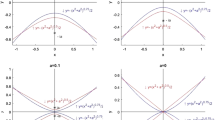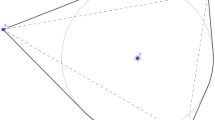Abstract
We develop a toolbox for proving decouplings into boxes with diameter smaller than the canonical scale. As an application of this new technique, we solve three problems for which earlier methods have failed. We start by verifying the small cap decoupling for the parabola. Then we find sharp estimates for exponential sums with small frequency separation on the moment curve in \(\mathbb {R}^3\). This part of the work relies on recent improved Kakeya-type estimates for planar tubes, as well as on new multilinear incidence bounds for plates and planks. We also combine our method with the recent advance on the reverse square function estimate, in order to prove small cap decoupling into square-like caps for the two dimensional cone. The Appendix by Roger Heath-Brown contains an application of the new exponential sum estimates for the moment curve, to the Riemann zeta-function.




Similar content being viewed by others
References
E. Bombieri and H. Iwaniec. Some mean value theorems for exponential sums. Ann. Scuola Norm. Sup. Pisa Cl. Sci., (4)13 (1986), 473–486
J. Bourgain. Decoupling inequalities and some mean-value theorems. J. Anal. Math., 133 (2017), 313–334
J. Bourgain. Decoupling, exponential sums and the Riemann zeta function. J. Amer. Math. Soc., (1)30 (2017), 205–224
J. Bourgain. Moment inequalities for trigonometric polynomials with spectrum in curved hypersurfaces. Israel J. Math., (1)193 (2013), 441–458
J. Bourgain and C. Demeter. The proof of the \(l^2\) Decoupling Conjecture. Annals of Math., (1)182 (2015), 351–389
J. Bourgain and C. Demeter. Decouplings for surfaces in \(\mathbb{R}^4\). J. Funct. Anal., (4)270 (2016), 1299–1318
J. Bourgain and C. Demeter. Decouplings for curves and hypersurfaces with nonzero Gaussian curvature. J. d’Analyse Mathematique, 133 (2017), 279–311
J. Bourgain, C. Demeter and L. Guth. Proof of the main conjecture in Vinogradov’s mean value theorem for degrees higher than three. Ann. of Math. (2), (2)184 (2016), 633–682
J. Bourgain, C. Demeter and D. Kemp. Decouplings for real analytic surfaces of revolution, to appear in Geometric Aspects of Functional Analysis – Israel Seminar (GAFA) 2017–2019, Lecture Notes in Mathematics 2256.
J. Bourgain and L. Guth. Bounds on oscillatory integral operators based on multilinear estimates. GAFA, (6)21 (2011), 1239–1265
J. Bourgain and N. Watt. Decoupling for perturbed cones and mean square of \(\zeta (\frac{1}{2}+it)\). Int. Math. Res. Not. IMRN, (17) (2018), 5219–5296.
J. Bourgain and N. Watt. Mean square of zeta function, Gauss circle problem and divisor problem revisited. Available on arXiv.
C. Demeter. Fourier Restriction, Decoupling and Applications. Cambridge University Press, Cambridge (2020).
S.W. Graham and G. Kolesnik. Van der Corput’s Method of Exponential Sums. Cambridge University Press, Cambridge (1991).
L. Guth, N. Solomon and H. Wang. Incidence estimates for well spaced tubes. Available on arXiv.
L. Guth, H. Wang and R. Zhang. The square function conjecture for the cone in\(\mathbb{R}^3\), to be available soon.
L. Guth, A. Iosevich, Y. Ou and H. Wang. On Falconer’s distance set problem in the plane. Available on arXiv.
D.R. Heath-Brown. A New \(k\)-th Derivative Estimate for Exponential Sums via Vinogradov’s Mean Value. Proc. Steklov Inst. Math., (1)296 (2017), 88–103
E.C. Titchmarsh. The Theory of the Riemann Zeta-Function, Second edition. Clarendon Press, Oxford University Press, New York (1986).
T.D. Wooley. The cubic case of the main conjecture in Vinogradov’s mean value theorem. Adv. Math., 294 (2016), 532–561
T.D. Wooley. Rational solutions of pairs of diagonal equations, one cubic and one quadratic. Proc. Lond. Math. Soc. (3) (2)110 (2015), 325–356
Acknowledgements
This paper has benefitted from motivating conversations between the first author, Jean Bourgain and Shaoming Guo. We are grateful to a very careful referee, whose many suggestions led to the improvement of our presentation.
Author information
Authors and Affiliations
Corresponding author
Additional information
To the memory of Jean Bourgain.
Publisher's Note
Springer Nature remains neutral with regard to jurisdictional claims in published maps and institutional affiliations.
The first author is partially supported by the NSF Grant DMS-1800305. The second author is partially supported by a Simons Investigator Award. The third author was partially supported by the Simons Foundation grant of David Jerison while she was at MIT, and supported by the S.S. Chern Foundation for Mathematics Research Fund and by the NSF while at IAS.
Appendix: An Improved Fourth Derivative Estimate for Exponential Sums (D.R. Heath-Brown, Mathematical Institute, Oxford)
Appendix: An Improved Fourth Derivative Estimate for Exponential Sums (D.R. Heath-Brown, Mathematical Institute, Oxford)
In this appendix we will show how Theorem 3.3 may be applied to establish an improved version of the “fourth derivative estimate” for exponential sums. The classical van der Corput k-th derivative estimate (Titchmarsh [Tit86, Theorems 5.9, 5.11, & 5.13], for example), can be given as follows. Suppose that \(k\ge 2\) is an integer, and let \(f(x):[0,N]\rightarrow \mathbb {R}\) have a continuous k-th derivative on (0, N) with \(0<\lambda _k\le f^{(k)}(x)\le A\lambda _k\). Then
where the implied constant is independent of k.
By using the (essentially) optimal estimate for Vinogradov’s mean value, as proved by Bourgain, Demeter and Guth [BDG16], one can obtain an alternative bound
for any fixed \(\varepsilon >0\) (see Heath-Brown [Hea17, Theorem 1]). In most situations this is superior to the classical estimate as soon as \(k\ge 4\), and the object of this appendix is to show how Theorem 3.3 of the present paper allows one to produce a further improvement in the case \(k=4\). The result we obtain is the following.
Theorem 12.1
Let \(f(x):[0,N]\rightarrow \mathbb {R}\) have a continuous 4th derivative on (0, N) with \(0<\lambda _4\le f^{(4)}(x)\le A\lambda _4\) for some constant \(A\ge 1\). Write \(\lambda _4=N^{-\varpi }\), and suppose that \(N^{-2}\lesssim \lambda _4\lesssim N^{-1}\). Then
for any fixed \(\varepsilon >0\).
In practice one would usually apply the third derivative bound when \(\lambda _4\lesssim N^{-2}\), giving a stronger result than can be obtained from the fourth derivative estimates. When \(k=4\) and \(\lambda _4=N^{-\varpi }\) the bound (68) yields
while (69) produces
Thus we get a significant saving when \(N^{-2}\lesssim \lambda _4\lesssim N^{-1}\).
As an application of Theorem 12.1 we will prove a bound for the Lindelöf \(\mu (\sigma )\) function associated to the Riemann Zeta-function.
Theorem 12.2
We have
for any fixed \(\varepsilon >0\), so that \(\mu (\tfrac{11}{15})\le \tfrac{1}{15}\).
Strictly speaking, we do not claim that this bound is new. Indeed given the plethora of published bounds and the convexity of \(\mu (\sigma )\) it is not easy to say with confidence that a given result is new. Moreover one can make further small improvements on Theorem 12.2 by using exponent pairs to sharpen the application of the third derivative bound in the argument below, and by replacing the trivial bound (for small N) by the case \(k=5\) of (68). However our main purpose with Theorem 12.2 is to demonstrate a neat bound coming directly from the new fourth derivative estimate.
The proof of Theorem 12.1 begins by following the argument from [Hea17, Section 2]. We assume that \(k=4\), although the initial stages of the method work for arbitrary \(k\ge 3\). We write \(H=[(A\lambda _k)^{-1/k}]\) and for \(\varvec{\alpha }\in [0,1]^{k-1}\) we define
If we set \(\alpha ^*=f^{(k-1)}(0)/(k-1)!\) then whenever \(\nu (\varvec{\alpha })\not =0\) we must have
for some \(n\le N-H\). If we write this as \(|\alpha _{k-1}-\alpha ^*|\le \xi \), say, then in our situation we have \(\xi \lesssim _A N\lambda _4\), since \(\lambda _4\gg N^{-2}\). We may now replace Lemma 1 of [Hea17] by the estimate
with
and
for some \(x\le H\). Note that the argument of [Hea17, Section 2] works for any real \(s\ge 1\).
We now specialize to \(k=4\), and plan to apply Theorem 3.3. As remarked in connection with Theorem 3.3 the proof allows us to replace the range \([0,N^{-\beta }]\) by any interval of length \(N^{-\beta }\). What is less clear is whether the estimate of the theorem holds uniformly with respect to \(\beta \). To clarify this point we suppose that the theorem yields the bounds
for \(0\le \beta \le \tfrac{3}{2}\), uniformly in \(\tau \). Set \(R=\lceil \tfrac{3}{2}\varepsilon \rceil \) and \(r=\lceil \tfrac{2}{3} R\beta \rceil \). If we then write \(\beta _r=3r/2R\) it follows that \(0\le \beta _r\le 3/2\) and \(\beta _r-\varepsilon <\beta \le \beta _r\). We now observe firstly that
and secondly that the interval \([\tau ,\tau +N^{-\beta }]\) can be covered by at most \(N^{\varepsilon }\) intervals of length \(N^{-\beta _r}\). Thus
We therefore see that Theorem 3.3 holds (with \(\varepsilon \) replaced by \(4\varepsilon \)) with implied constant \(C(\varepsilon )=\max _{r\le R}C(\varepsilon ,\beta _r)\) depending only on \(\varepsilon \).
We proceed to apply this uniform version of Theorem 3.3. We have assumed that \(\Lambda _4\le cN^{-1}\) for some constant c. With this in mind we define \(\beta \) by the relation
We then have \(0\le \beta \le \tfrac{3}{2}\) as required. Moreover,
and \(1\lesssim \varpi \lesssim 1\), whence \(N=H^{4/\varpi +O(1/\log N)}\) and
We therefore see that
Since \(\xi \lesssim _A N\lambda _4\lesssim H^{-\beta }\) we can cover the range \([\alpha ^*-\xi ,\alpha ^*+\xi ]\) with \(O_A(1)\) intervals of length \(H^{-\beta }\). It then follows on taking \(s=6-\beta \) that
Moreover [Hea17, Lemma 3] yields \(\mathcal {N}\lesssim _{A,\varepsilon }N^{1+\varepsilon }\) when \(N^{-2}\lesssim \lambda _4\lesssim N^{-1}\). We therefore conclude that
However
whence
Theorem 12.1 then follows.
To deduce Theorem 12.2 it suffices by the approximate functional equation (see Chapter 2 in [GK91] or [Tit86]) to show that
for \(N\le t^{1/2}\) and any fixed \(\varepsilon >0\). The bound is trivial for \(N\le t^{1/4}\), and so we focus on the remaining range \(t^{1/4}\le N\le t^{1/2}\). When \(f(x)=t(\log x)/2\pi \) one may apply the third derivative estimate, taking \(\lambda _3\) to have order \(tN^{-3}\). The bound (67) then shows that
This gives a satisfactory bound \(O(N^{11/15}t^{1/15})\) when \(t^{3/7}\le N\le t^{1/2}\). For the remaining range \(t^{1/4}\le N\le t^{3/7}\) we use our various fourth derivative estimates, with \(\lambda _4\) of order \(tN^{-4}\). When \(t^{1/4}\le N\le t^{1/3}\) the bound (70) yields
For \(t^{5/12}\le N\le t^{3/7}\) we have \(N^{-5/3}\lesssim \lambda _4\lesssim N^{-8/5}\) so that (71) produces an estimate
Finally, when \(t^{1/3}\le N\le t^{5/12}\) we find that \(N^{-8/5}\lesssim \lambda _4\lesssim N^{-1}\). In this case (71) shows that
If we write \(t=N^{\tau }\) we will have \(\tfrac{12}{5}\le \tau \le 3\), and \(\varpi =4-\tau +O(1/\log N)\). It therefore suffices to show that
for \(\tfrac{12}{5}\le \tau \le 3\), and this is readily verified, completing the proof of Theorem 12.2. The reader will note that the critical case is that in which \(\lambda _4\) is of order \(N^{-5/3}\).
Mathematical Institute,
Radcliffe Observatory Quarter,
Woodstock Road,
Oxford
OX2 6GG
UK
rhb@maths.ox.ac.uk
Rights and permissions
About this article
Cite this article
Demeter, C., Guth, L. & Wang, H. Small cap decouplings. Geom. Funct. Anal. 30, 989–1062 (2020). https://doi.org/10.1007/s00039-020-00541-5
Received:
Revised:
Accepted:
Published:
Issue Date:
DOI: https://doi.org/10.1007/s00039-020-00541-5




